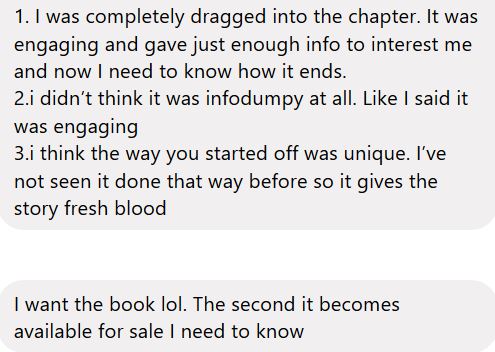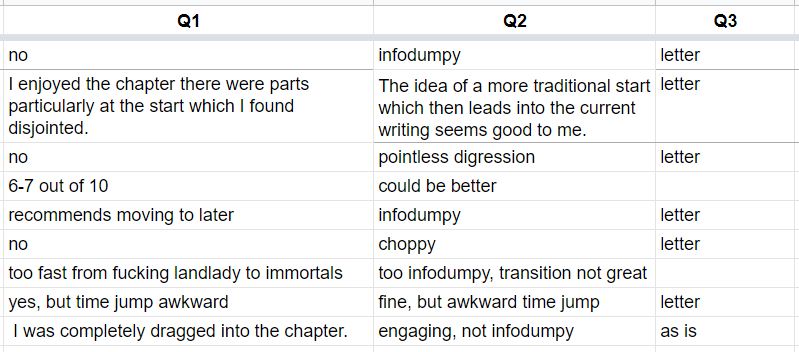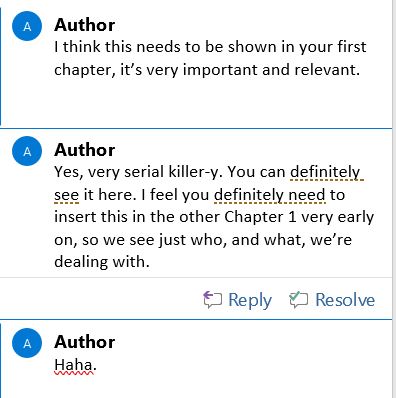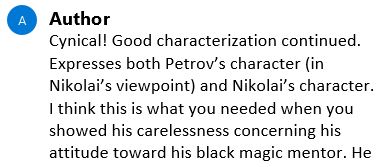When I first wrote my book, I began with a flash forward that set up my main character as a calculating cult leader who manipulated his followers into sacrificing themselves for a cause. It did a great job of establishing my character and my critique partners loved it. Unfortunately, fantasy alpha readers didn’t. It took place too far in the future for them to care, and the tone (dark and brooding) was vastly different from the rest of the book.
I cut the flash forward, but I was left with a chapter 1 that was never designed to introduce Nikolai with the same level of depth. Lacking the flash forward, alpha readers of my chapter 1 consistently had questions about Nikolai’s character. Why was he like this? What was his tragic back story? And why did he care so much about learning black magic? All valid questions (Except the last one. You really have to ask why a young guy wants to make things explode? Quite frankly, I am astounded how many people ask this. It’s like asking why young men like Call of Duty or Halo.), but not something I could address so early in the book. If I had a traditional protagonist, someone more empathetic, readers would probably be willing to wait a few chapters for those answers. But I don’t have a traditional protagonist.
I have a psychopath.
I attempted to correct the characterization issue by writing a new introduction that hung a flag on it. I started with a paragraph that was the core philosophy of my character, and spent the next page and a half trying to connect that one paragraph to my inciting incident. I ended up with something very similar to the introduction to one of my favorite books, The Princess Bride (at least the “story” part of the book). It opens with a series of comical vignettes that have little to do with the story, but do an excellent job establishing tone and setting expectations. This book is going to be funny, it screams.
My opening was much the same, with a very in-your-face vignette of Nikolai’s activities when he first arrived in Haven. The way I saw it, this segment had one job—announce loud and clear to the reader that this book unapologetically starred a villainous protagonist—and for that it was very effective. The new intro got a lot of gasps and laughs over Nikolai’s over-the-top behavior, and readers stopped asking me why he was the way he was.
The new intro also won me a few super fans, people in my beta reader pool who tore through the book in a matter of days and were super pumped to read the next. These readers loved the introduction, describing it as unique, funny, and refreshingly to the point. I know exactly what they mean, because I dig that kind of opening too.

If you know anything about storytelling, you’ll know at this point things take a turn.
I began shopping around for editors, which includes sending a sample of your first chapter. One editor mentioned my intro might have too much narrative and suggested I break it up a bit with dialogue. Two others said it had too much exposition that, while “essential,” should be weaved into the story elsewhere. Most of my exposition was irrelevant to the story, existing for the sole purpose of building character in that intro, so their suggestions that I move it elsewhere weren’t particularly helpful. At that point, it should just be cut.
One of the things I’ve heard in writing is that “If one person says something, that’s their opinion. If three people say it, you should take it under advisement.” While not all the editors brought up these issues, at least three did, and editors know a hell of a lot more than the average critique partner. Still, I wanted to see what readers thought. I did the logical thing and posted in several Facebook groups asking for beta readers for chapter one. I included three questions:
- Does the chapter pull you along from start to finish?
- Did you find it infodumpy?
- Should it start where it is, or begin at the inciting incident (the letter)?
Eighteen people responded and nine followed through. I tracked them on a spreadsheet because that’s how I roll. As you can see below, the majority were less than impressed and found it a bit too infodumpy (though there’s another superfan on the end there).

Disappointed, I rewrote the intro, making it much shorter and more traditional. It had none of the humor or tone setting of the previous version. I sent it to my editor, and she said it was much better.
They say that if you’re ever caught in indecision, you can flip a coin to find out how you really feel. If the result you get makes you feel relieved, then that’s what you should go with. If the result makes you feel disappointed, then you know to pick the other one. Either way, you know
The rewrite ate at me constantly. I could see why it was technically better, but I didn’t like it. My fans didn’t like it. I tried to figure out a way to combine the two and came up with nothing. I made a list of the pros and cons of the original opening.
Pros:
- Voice
- Character
- Humor
Cons:
- Too long
- Too much exposition
- Needed better transition
The third con in particular caught my eye. Looking back at my beta reader responses, several people called it choppy and disjointed. I knew the transition between the intro and the inciting incident was bad. Could that be fixed?
Then I got a late response from one of the readers. Did I still want input? I sent her the new, gutted version my editor had liked, and got the questions once again.


Right back where I started. The second of these was in response to a line that had previously gotten laughs with many readers. Without the intro, the joke hadn’t landed. It was frustrating as hell. It had been so long (over a year) since my alpha readers, that I’d forgotten this was the why I’d done the villainous intro sequence in the first place.
Out of curiosity, I tossed her the old version to see what she thought.

BAM. She immediately sees the necessity of that opening paragraph, the one that gives Nikolai’s core philosophy in life. She laughed three times with the old introduction, and suddenly she was praising my characterization. She went from calling Nikolai “nasty” to complaining that he didn’t go far enough and kill a guy.


To her credit, the she pointed out some issues with my intros that could be addressed. I banged out the third version that solved the problems and sent it back to my readers. The response was lackluster. Basically, “better than version 2, but still not as good as version 1.” I wasn’t sold on version 3 either. It had characterization, but lacked humor and tone.
I went back to my villainous intro, gutted all extraneous exposition, added dialogue to break up the narrative a bit, and fixed the transition (I hope). Then I sent it to a trusted reader and he recommended even more places where it could be tightened.
So here I am, back with my unabashedly villainous introduction. It won’t appeal to as many readers, but it should appeal to the right readers.
Copyright © 2020 Val Neil. All rights reserved. Special thanks to Tim for all your help. You rock.





